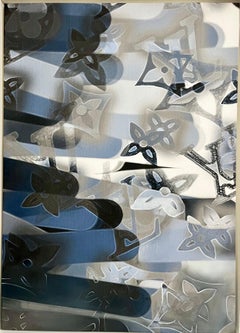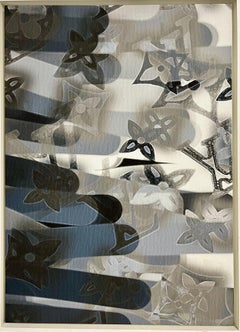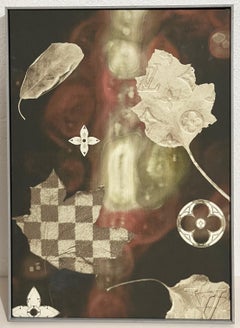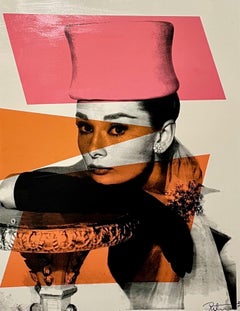Want more images or videos?
Request additional images or videos from the seller
1 of 5
Ernest Tino TrovaFalling Man1967
1967
$600List Price
About the Item
- Creator:Ernest Tino Trova (1927 - 2009, American)
- Creation Year:1967
- Dimensions:Height: 28.5 in (72.39 cm)Width: 29 in (73.66 cm)
- Medium:
- Period:
- Condition:1967 poster from MIT, mounted to board. Cannot be rolled.
- Gallery Location:Surfside, FL
- Reference Number:1stDibs: LU38210886292
Ernest Tino Trova
Known for his Falling Man series in abstract figural sculpture, he created hard-edge images that brought him widespread attention because they seem to strike a chord of empathy with viewers who recognized themselves as human beings challenged by a technological society. Also, they are the only creatures aware of their mortality. He is considered highly innovative because of his successful combining of technological methods to create his art. Interpretation as to overall meanings vary with some thinking that it refers to the fall of man in the religious sense and others seeing it as a commentary on the tragic mechanization of society that reduces human beings. Trova has said that "falling" refers to the fact that man moves from one position to the next in an eventual fall to inevitable oblivion" (Kultermann 11). He has lived his entire life in St. Louis, Missouri although his reputation is nationwide. He did not think it necessary to study art because he believed in his own instincts, although he drew from a variety of sources including figurative painters such as Francis Bacon, Jean Dubuffet, and Willem DeKooning. The Falling Man series resulted from a unique offer from the Famous-Barr Department Store in St. Louis, where he had worked as a window decorator in his twenties. Store personnel told him that in exchange for creating a series of works to exhibit at the city's 1964 bicentennial celebration, he could have unlimited access to the store's materials and workers. The store's display department was a great setting for him to be creative with his interest in Pop Art, and this project gave him assembly-line assistance of carpenters, electricians, and painters. The result was that all images had Falling Man figures, and this included paintings, assemblages, collages, and movable sculpture, both electronic and hand driven. After the Bi-centennial, many of the pieces were then shipped to the Pace Gallery in New York City and received critical acclaim. Of his technique, he has explained that he first creates a cardboard model and then works from there, often making it life size. He is much more interested in variations of shape and form rather than color. Ernest Tino Trova died at his home in Richmond Heights, near St. Louis, Missouri on March 8, 2009 at the age of 82. (Obituary.New York Times March 13, 2009.)
About the Seller
4.9
Platinum Seller
Premium sellers with a 4.7+ rating and 24-hour response times
Established in 1995
1stDibs seller since 2014
1,833 sales on 1stDibs
Typical response time: 1 hour
Authenticity Guarantee
In the unlikely event there’s an issue with an item’s authenticity, contact us within 1 year for a full refund. DetailsMoney-Back Guarantee
If your item is not as described, is damaged in transit, or does not arrive, contact us within 7 days for a full refund. Details24-Hour Cancellation
You have a 24-hour grace period in which to reconsider your purchase, with no questions asked.Vetted Professional Sellers
Our world-class sellers must adhere to strict standards for service and quality, maintaining the integrity of our listings.Price-Match Guarantee
If you find that a seller listed the same item for a lower price elsewhere, we’ll match it.Trusted Global Delivery
Our best-in-class carrier network provides specialized shipping options worldwide, including custom delivery.You May Also Like
20th Century by Mario Schifano Untitled Silk-screen printing on canvas
By Mario Schifano
Located in Milano, Lombardia
Mario Schifano (Khoms, Libya, 1934 – Rome, Italy, 1998)
Title: Untitled
Medium: silk-screen printing on canvas
Dimensions: 91.5 x 91.5 x 7.2 cm
Year: first half of the 1970s
Signed “...
Category
1970s Contemporary Mixed Media
Materials
Canvas, Screen
$12,729 Sale Price
20% Off
H 36.03 in W 36.03 in D 2.84 in
LIFE IS FATAL rare Hand-Finished Screen Print Signed and Numbered by the Artist
By Prefab77
Located in Palm Desert, CA
LIFE IS FATAL II (2019) by Prefab77
Hand Finished Mix of Acrylic, Screen Print, Spray Paint, Stencil, and UV Ink on 350 gsm Fabriano Cotton Paper
70 x 100 cm
Limited Edition of 15
Si...
Category
2010s Street Art Mixed Media
Materials
Spray Paint, Acrylic, Screen, Stencil
$891
H 39.38 in W 27.56 in D 0.04 in
Paheli #Patal Lok Netherworld
By Natasha Kumar
Located in london , GB
Paheli #Patal Lok Netherworld
hand drawn screenprint on paper with 22 carat gold leaf (variations to the texture and finish of the gold make each piece unique)
3 (edition of 3) th...
Category
21st Century and Contemporary Contemporary Mixed Media
Materials
Gold Leaf
Untitled, screen print on mirror by Carlos Rolon (abstract geometric design)
By Carlos Rolón
Located in New York, NY
Known for his elaborately crafted paintings and ornate sculptures, Rolón worked with master printer Luther Davis of the renowned Axelle Editions print shop to create a hybrid silkscr...
Category
2010s Abstract Geometric Mixed Media
Materials
Glass, Mirror, Screen
$2,500
H 24 in W 24 in D 0.5 in
Cats Black, 2022
By Ai Weiwei
Located in Santa Monica, CA
Lovely work from the artist.
Category
21st Century and Contemporary Mixed Media
Materials
Screen
Red Mt. Fuji 1982, 1982
By Yayoi Kusama
Located in Santa Monica, CA
Lovely work from the artist.
Category
21st Century and Contemporary Mixed Media
Materials
Screen
Red Mt. Fuji 1982, 1982
By Yayoi Kusama
Located in Santa Monica, CA
Lovely work from the artist.
Category
21st Century and Contemporary Mixed Media
Materials
Screen
Bags
Located in Santa Monica, CA
Silkscreen/Collage on Retail Bags
Category
21st Century and Contemporary Pop Art Mixed Media
Materials
Screen
Study for Kyle at Universal Music Group (Lil Wayne)
By Skylar Fein
Located in New Orleans, LA
Skylar Fein was born in Greenwich Village and raised in the Bronx. He has had many careers including teaching nonviolent resistance under the umbrella of the Quakers, working for a g...
Category
21st Century and Contemporary Pop Art Mixed Media
Materials
Mixed Media, Screen
GE
By Skylar Fein
Located in New Orleans, LA
Skylar Fein was born in Greenwich Village and raised in the Bronx. He has had many careers including teaching nonviolent resistance under the umbrella of the Quakers, working for a g...
Category
21st Century and Contemporary Pop Art Mixed Media
Materials
Acrylic, Mixed Media, Screen
More From This Seller
View AllLarge Mixed Media Unique Art Photo Louis Vuitton Tim White Sobieski Photograph
Located in Surfside, FL
Tim White-Sobieski
Alpha LV, 2005
Unique photo print on canvas
42 X 30 in
Tim White Sobieski has been commissioned by LVMH multiple times, and in 2005, was invited to create an artwork for the new Louis Vuitton Flagship Store on Champs-Elysees in Paris alongside artists James Turrell and Olafur Eliasson. The project consisted of a 24-meter programmed fiber-optics video wall. Another colossal video wall was installed at the Petit Palais for the celebration of the launch. This was a unique cooperation of the three artists. In 2006, the Louis Vuitton Company invited Tim White-Sobieski back to participate in an exhibition entitled "Icons", an interpretation of the iconic logo-bags. Other artists included Marc Jacobs, Zaha Hadid, Ugo Rondinone, Sylvie Fleury, Shigeru Ban, Robert Wilson and Andrée Putman.
From the 2006 ‘Icones’ exhibition at Espace Louis Vuitton, Paris.
celebrating Marc Jacobs’ reinvention of their iconic pieces,
works by Andree Putman, LV invited the architects Zaha Hadid and Shigeru Ban, the video artist Tim White-Sobieski, the director-scenographer Robert Wilson, and the artists James Turrell, Shigeru Ban, Sylvie Fleury, Bruno Peinado, and Ugo Rondinone to riff on their fashion logos
Louis Vuitton's classic designs are an inextricable part of chic travel history. From trunks to leather bags to wine holders, their styles have traveled across time and fashion, becoming classics that never look old. With the genius of Marc Jacobs, these icons have entered new domains where art and fashion are directly linked.
Tim White is a video and installation artist based in New York and Berlin. He was educated as an architect and dedicated himself to visual art and filmmaking, exploring the fields of painting, sculpture, photography, video, video installations and light installations throughout his career. He began showing in New York in the early 1990s with his "Blue Paintings." Emphasis on the role of the subconscious in his paintings had affinities with visual abstractionism and literary existentialism.
He has consistently been at the technological forefront of video and light art, being called a "video maverick" and "an abstract "'painter of motion.'"
Tim White-Sobieski was born in 1961 and emigrated to the United States in 1993. He attended New York University and Parsons School of Design before embarking on a career in art.
Much of his work draws from literary work that has inspired the artist, and he has often featured icons of American literature in his installations. Writers such as Walt Whitman, John Steinbeck, John Updike, Kurt Vonnegut, J.D. Salinger, William Faulkner, and Robert Penn Warren all have a permanent presence in Tim White-Sobieski’s oeuvre.
Musically, White-Sobieski composes most of his own film and video soundtracks, but also incorporates the work of his contemporaries such as Brian Eno, David Byrne, Robert Fripp...
Category
Early 2000s Contemporary Mixed Media
Materials
Canvas, Mixed Media, Photogram, Screen
Mixed Media Unique Art Photo Louis Vuitton, Paris, Tim White Sobieski Photograph
Located in Surfside, FL
Tim White-Sobieski
Alpha LV#1, 2005
Unique photo print on canvas
28 × 20 in 71.1 × 50.8 cm
Tim White Sobieski has been commissioned by LVMH multiple times, and in 2005, was invited to create an artwork for the new Louis Vuitton Flagship Store on Champs-Elysees in Paris alongside artists James Turrell and Olafur Eliasson. The project consisted of a 24-meter programmed fiber-optics video wall. Another colossal video wall was installed at the Petit Palais for the celebration of the launch. This was a unique cooperation of the three artists. In 2006, the Louis Vuitton Company invited Tim White-Sobieski back to participate in an exhibition entitled "Icons", an interpretation of the iconic logo-bags. Other artists included Marc Jacobs, Zaha Hadid, Ugo Rondinone, Sylvie Fleury, Shigeru Ban, Robert Wilson and Andrée Putman.
From the 2006 ‘Icones’ exhibition at Espace Louis Vuitton, Paris.
celebrating Marc Jacobs’ reinvention of their iconic pieces,
works by Andree Putman, LV invited the architects Zaha Hadid and Shigeru Ban, the video artist Tim White-Sobieski, the director-scenographer Robert Wilson, and the artists James Turrell, Shigeru Ban, Sylvie Fleury, Bruno Peinado, and Ugo Rondinone to riff on their fashion logos
Louis Vuitton's classic designs are an inextricable part of chic travel history. From trunks to leather bags to wine holders, their styles have traveled across time and fashion, becoming classics that never look old. With the genius of Marc Jacobs, these icons have entered new domains where art and fashion are directly linked.
Tim White is a video and installation artist based in New York and Berlin. He was educated as an architect and dedicated himself to visual art and filmmaking, exploring the fields of painting, sculpture, photography, video, video installations and light installations throughout his career. He began showing in New York in the early 1990s with his "Blue Paintings." Emphasis on the role of the subconscious in his paintings had affinities with visual abstractionism and literary existentialism.
He has consistently been at the technological forefront of video and light art, being called a "video maverick" and "an abstract "'painter of motion.'"
Tim White-Sobieski was born in 1961 and emigrated to the United States in 1993. He attended New York University and Parsons School of Design before embarking on a career in art.
Much of his work draws from literary work that has inspired the artist, and he has often featured icons of American literature in his installations. Writers such as Walt Whitman, John Steinbeck, John Updike, Kurt Vonnegut, J.D. Salinger, William Faulkner, and Robert Penn Warren all have a permanent presence in Tim White-Sobieski’s oeuvre.
Musically, White-Sobieski composes most of his own film and video soundtracks, but also incorporates the work of his contemporaries such as Brian Eno, David Byrne, Robert Fripp...
Category
Early 2000s Contemporary Mixed Media
Materials
Canvas, Mixed Media, Photogram, Screen
Mixed Media Unique Art Photo Louis Vuitton, Paris, Tim White Sobieski Photograph
Located in Surfside, FL
Tim White-Sobieski
Alpha LV#1, 2005
Unique photo screenprint on canvas
28 × 20 in 71.1 × 50.8 cm
Tim White Sobieski has been commissioned by LVMH multiple times, and in 2005, was invited to create an artwork for the new Louis Vuitton Flagship Store on Champs-Elysees in Paris alongside artists James Turrell and Olafur Eliasson. The project consisted of a 24-meter programmed fiber-optics video wall. Another colossal video wall was installed at the Petit Palais for the celebration of the launch. This was a unique cooperation of the three artists. In 2006, the Louis Vuitton Company invited Tim White-Sobieski back to participate in an exhibition entitled "Icons", an interpretation of the iconic logo-bags. Other artists included Marc Jacobs, Zaha Hadid, Ugo Rondinone, Sylvie Fleury, Shigeru Ban, Robert Wilson and Andrée Putman.
From the 2006 ‘Icones’ exhibition at Espace Louis Vuitton, Paris.
celebrating Marc Jacobs’ reinvention of their iconic pieces,
works by Andree Putman, LV invited the architects Zaha Hadid and Shigeru Ban, the video artist Tim White-Sobieski, the director-scenographer Robert Wilson, and the artists James Turrell, Shigeru Ban, Sylvie Fleury, Bruno Peinado, and Ugo Rondinone to riff on their fashion logos
Louis Vuitton's classic designs are an inextricable part of chic travel history. From trunks to leather bags to wine holders, their styles have traveled across time and fashion, becoming classics that never look old. With the genius of Marc Jacobs, these icons have entered new domains where art and fashion are directly linked.
Tim White is a video and installation artist based in New York and Berlin. He was educated as an architect and dedicated himself to visual art and filmmaking, exploring the fields of painting, sculpture, photography, video, video installations and light installations throughout his career. He began showing in New York in the early 1990s with his "Blue Paintings." Emphasis on the role of the subconscious in his paintings had affinities with visual abstractionism and literary existentialism.
He has consistently been at the technological forefront of video and light art, being called a "video maverick" and "an abstract "'painter of motion.'"
Tim White-Sobieski was born in 1961 and emigrated to the United States in 1993. He attended New York University and Parsons School of Design before embarking on a career in art.
Much of his work draws from literary work that has inspired the artist, and he has often featured icons of American literature in his installations. Writers such as Walt Whitman, John Steinbeck, John Updike, Kurt Vonnegut, J.D. Salinger, William Faulkner, and Robert Penn Warren all have a permanent presence in Tim White-Sobieski’s oeuvre.
Musically, White-Sobieski composes most of his own film and video soundtracks, but also incorporates the work of his contemporaries such as Brian Eno, David Byrne, Robert Fripp...
Category
Early 2000s Contemporary Mixed Media
Materials
Canvas, Mixed Media, Photogram, Screen
Pop Art Peter Tunney Hand Pulled Silkscreen with Hand Coloring Painting Brando
By Peter Tunney
Located in Surfside, FL
Peter Tunney (b. 1961)
Audrey Hepburn
2015
Acrylic paint
Hand-pulled silkscreen with hand coloring on archival museum board.
40 x 32-1/4 inches (101.6 x 81.9 cm) (sheet)
Hand signed and dated in ink lower right
This is from a series titled The movie stars. Each is a unique silkscreen based on a licensed photograph of a movie actor. Each is unique due to the colors and patterns created by the artist on the photo image.
Audrey is a unique, hand-pulled silkscreen on hand painted archival museum board
Peter Tunney (b. 1961) is a legitimate force of nature with boundless creative energy, spreading his positive messages in unconventional ways and delivering works of art to a worldwide collector base. He creates in almost every medium: paint, collage, wood, photography, found objects, and discarded materials.
Peter Tunney is an American visual artist, publisher, art dealer, socialite and former Wall Street executive. He currently lives and works between New York City and Miami, Florida.
Tunney first made his fortune investing in biotechnology stocks on Wall Street. He then went onto found for the now closed SoHo gallery "The time is Always Now" where for nine years he showed a vast collection of work by the famed wildlife and fashion photographer Peter Beard, some of which was created on site. In 1994 Tunney was featured on Lifestyles of the Rich and Famous, as profiled by Robin Leach, and mentioned as one of the worlds most eligible bachelors. Later Beard and Tunney had a dramatic falling out. A tumultuous period followed leading to Tunney's living in the nightclub Crobar while doing a performance piece and eventually to rehab.
Today Tunney is a visual artist who works in the genre of neo-pop and whose work has been compared to that of Mel Bochner and Christopher Wool. Tunney is also known for his "Tunney Money" a system of art given in place of cash relinquished. one of his more high profile works so far was a billboard he did in the New York City borough of the Bronx alongside the Major Deegan Expressway which spelled out "GRATTITUDE" (in all capital letters with an extra T added on for emphasis) a word which Tunney has articulated frequently in his visual works. Tunney is also known for his surfboards which he turns into artworks often with his sayings such as "City of Dreams" or the aforementioned "GRATTITUDE" embellished onto them rendering the pieces of sports equipment works of art. In 2009 Tunney was commissioned by now Senior advisor to the President of the United States Jared Kushner (for whom Tunney had previously created a stencil overlay taken from his work "Don't Panic" for Kushner's newspaper The New York Observer) to establish an immersive work called "The Experiment" in the lobby of Kushner's fifth avenue sky scraper 666 Fifth Avenue.
In the Wynwood section of Miami he opened a gallery dedicated to his work called the "Peter Tunney Experience". Now forthcoming with the kickoff of the new NFL season at Hard Rock Stadium, home of the Miami Dolphins in Miami Gardens, Florida, is a large scale multiple mural project mostly of bright colorful abstract works some with a tip of the hat to Football, a project which arose out of a dialogue between Tunney, Jessica Goldman Srebnick (CEO of Goldman Global Arts and daughter of the late famed real estate developer, preservationist and arts visionary Tony Goldman) and the Dolphins. Among the artists whose efforts are included in the body of work are; Assume Vivid Astro Focus...
Category
2010s Contemporary Mixed Media
Materials
Paint, Screen
Pop Art Peter Tunney Hand Pulled Silkscreen with Hand Coloring Painting Brando
By Peter Tunney
Located in Surfside, FL
Peter Tunney (b. 1961)
Marlon Brando
2015
Acrylic paint
Hand-pulled silkscreen with hand coloring on archival museum board.
40 x 32-1/4 inches (101.6 x 81.9 cm) (sheet)
Hand signed and dated in ink lower right
This is from a series titled The movie stars. Each is a unique silkscreen based on a licensed photograph of a movie actor. Each is unique due to the colors and patterns created by the artist on the photo image.
Brando is a unique, hand-pulled silkscreen on hand painted archival museum board
Peter Tunney (b. 1961) is a legitimate force of nature with boundless creative energy, spreading his positive messages in unconventional ways and delivering works of art to a worldwide collector base. He creates in almost every medium: paint, collage, wood, photography, found objects, and discarded materials.
Peter Tunney is an American visual artist, publisher, art dealer, socialite and former Wall Street executive. He currently lives and works between New York City and Miami, Florida.
Tunney first made his fortune investing in biotechnology stocks on Wall Street. He then went onto found for the now closed SoHo gallery "The time is Always Now" where for nine years he showed a vast collection of work by the famed wildlife and fashion photographer Peter Beard, some of which was created on site. In 1994 Tunney was featured on Lifestyles of the Rich and Famous, as profiled by Robin Leach, and mentioned as one of the worlds most eligible bachelors. Later Beard and Tunney had a dramatic falling out. A tumultuous period followed leading to Tunney's living in the nightclub Crobar while doing a performance piece and eventually to rehab.
Today Tunney is a visual artist who works in the genre of neo-pop and whose work has been compared to that of Mel Bochner and Christopher Wool. Tunney is also known for his "Tunney Money" a system of art given in place of cash relinquished. one of his more high profile works so far was a billboard he did in the New York City borough of the Bronx alongside the Major Deegan Expressway which spelled out "GRATTITUDE" (in all capital letters with an extra T added on for emphasis) a word which Tunney has articulated frequently in his visual works. Tunney is also known for his surfboards which he turns into artworks often with his sayings such as "City of Dreams" or the aforementioned "GRATTITUDE" embellished onto them rendering the pieces of sports equipment works of art. In 2009 Tunney was commissioned by now Senior advisor to the President of the United States Jared Kushner (for whom Tunney had previously created a stencil overlay taken from his work "Don't Panic" for Kushner's newspaper The New York Observer) to establish an immersive work called "The Experiment" in the lobby of Kushner's fifth avenue sky scraper 666 Fifth Avenue.
In the Wynwood section of Miami he opened a gallery dedicated to his work called the "Peter Tunney Experience". Now forthcoming with the kickoff of the new NFL season at Hard Rock Stadium, home of the Miami Dolphins in Miami Gardens, Florida, is a large scale multiple mural project mostly of bright colorful abstract works some with a tip of the hat to Football, a project which arose out of a dialogue between Tunney, Jessica Goldman Srebnick (CEO of Goldman Global Arts and daughter of the late famed real estate developer, preservationist and arts visionary Tony Goldman) and the Dolphins. Among the artists whose efforts are included in the body of work are; Assume Vivid Astro Focus...
Category
2010s Contemporary Mixed Media
Materials
Paint, Screen
Mixed Media Painting SIlkscreen, Glitter Metal Flake, Acrylic Paint Darren Goins
Located in Surfside, FL
Darren Goins, (American, b. 1993)
Acrylic paint and metal flake glitter with silkscreen on paper
Not signed on front. (presumably signed verso but has not been examined out of fram...
Category
21st Century and Contemporary Contemporary Abstract Paintings
Materials
Glitter, Acrylic, Screen



